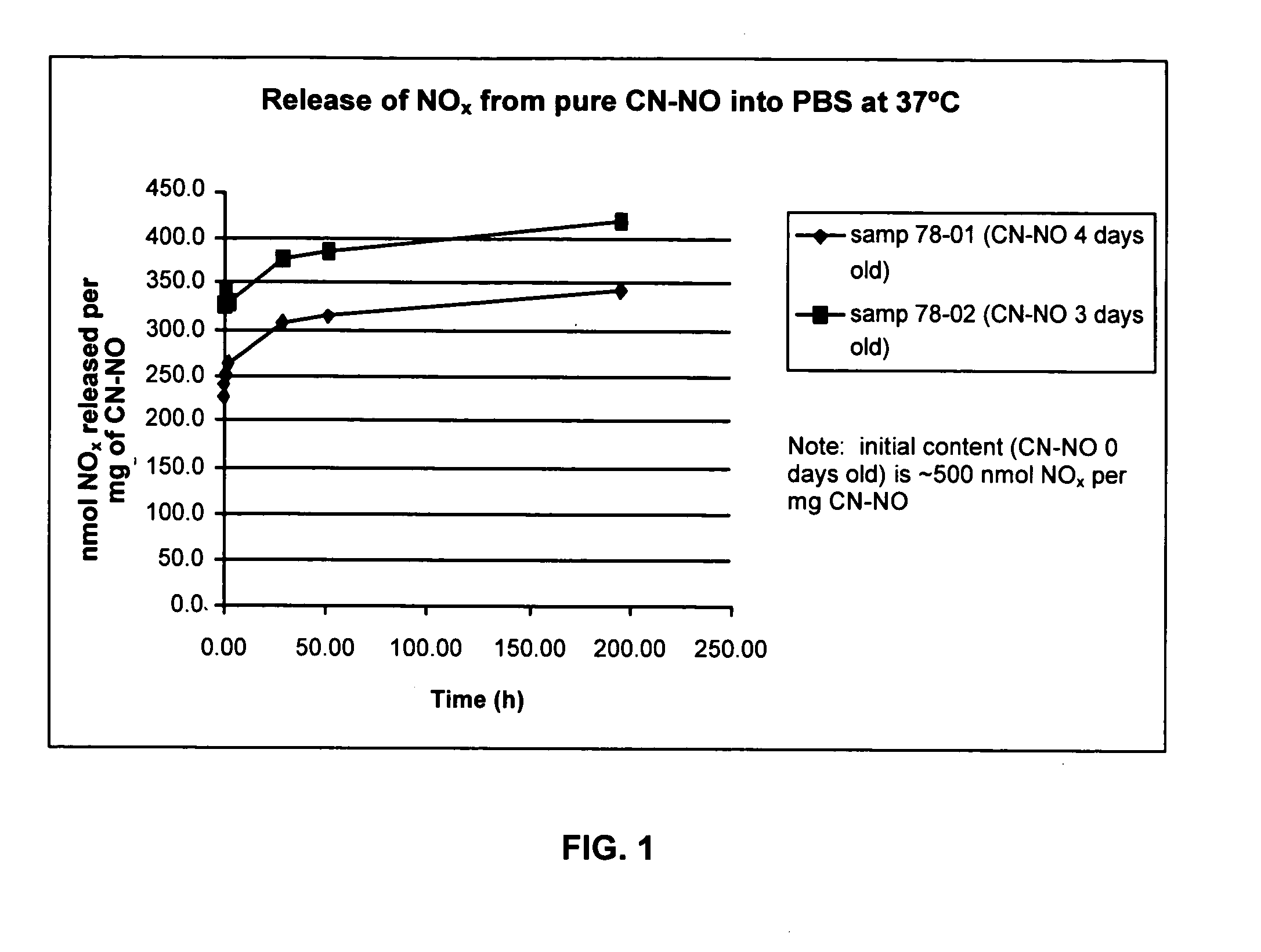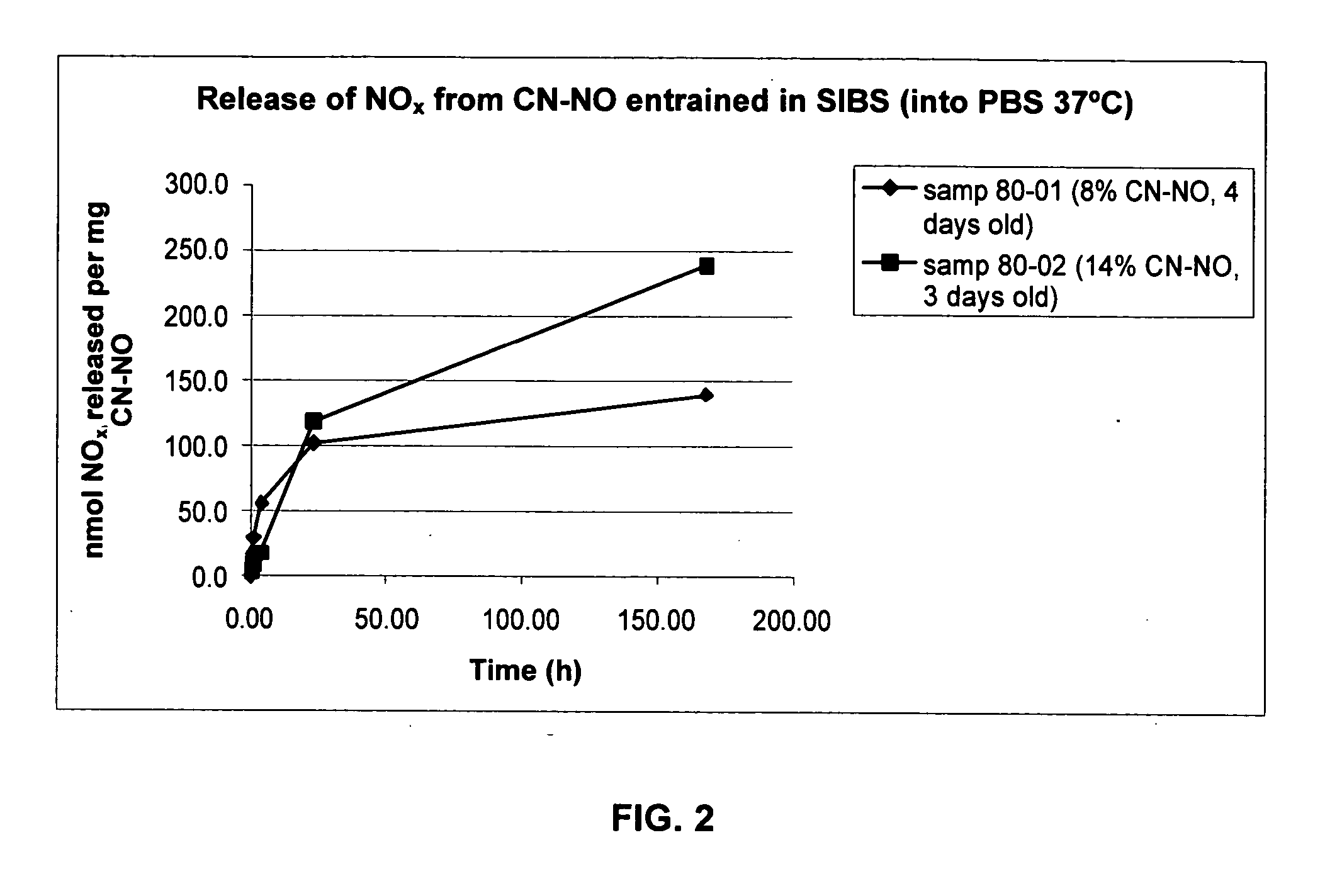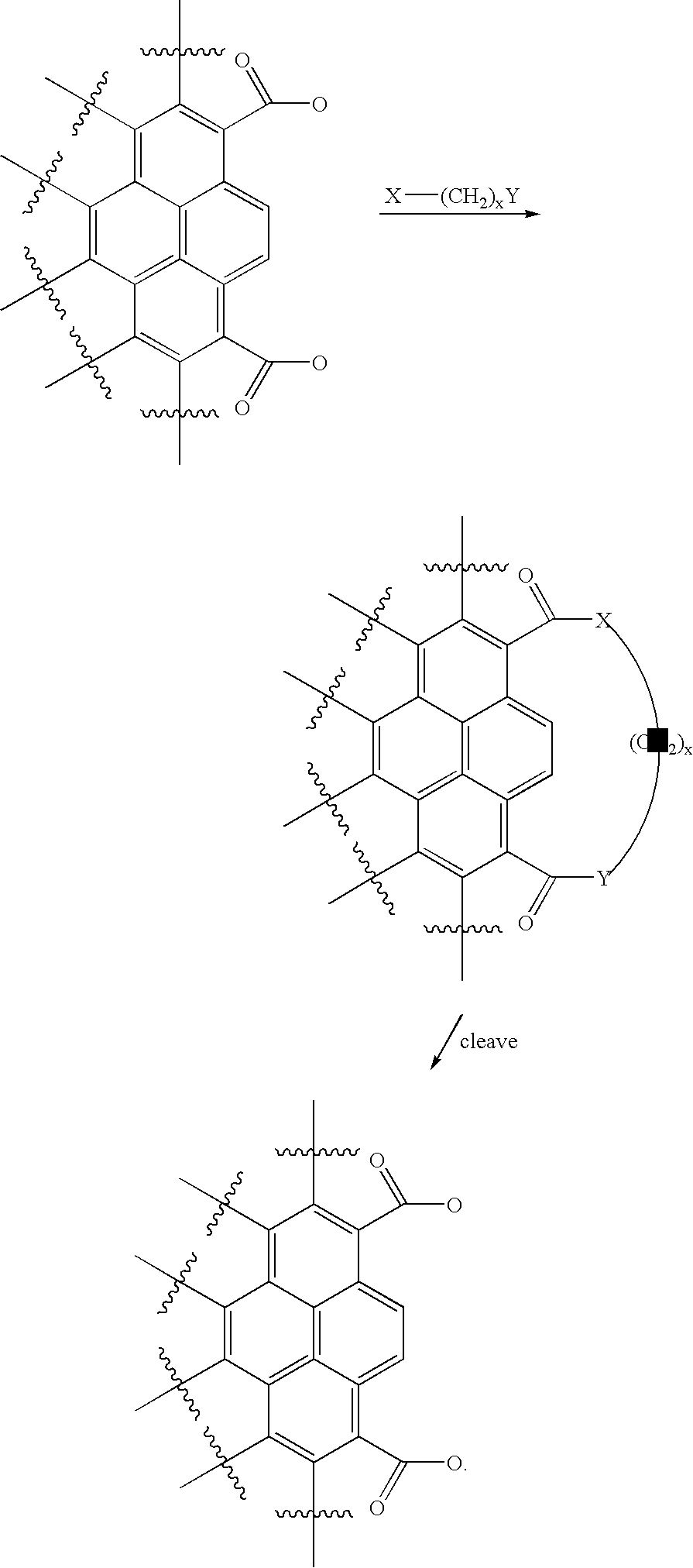Carbon nanotubules for storage of nitric oxide
a technology of carbon nanotubules and nitric oxide, which is applied in the field of carbon nanotubules for storage of nitric oxide, can solve the problems of preventing efficient storage and many difficulties in storing nitric oxide in discrete, and achieve the effect of convenient preparation
- Summary
- Abstract
- Description
- Claims
- Application Information
AI Technical Summary
Benefits of technology
Problems solved by technology
Method used
Image
Examples
example 1
Loading and Heat Assay
[0048] A 125 mL bottle with a poly(tetrafluoroethylene)-faced (PTFE-faced), silicone rubber open-top cap was filled with glass vials and glass wool to an extent that a 2 mL vial could be placed very nearly at the top of the bottle. Single-walled carbon nanotublules (hereinafter “CN”, Aldrich 519308, CarboLex AP-grade, 17.3 mg) were placed in a 2 mL vial, which was put into the 125 mL bottle. By means of a 6 inch needle, argon gas was blown slowly through the bottom of the 125 mL bottle for 25 minutes, with egress through a hypodermic needle at the top. By the same process, NO gas was blown through the bottom of the 125 mL bottle for 20 minutes; the NO gas was first blown through granular KOH and a water bubbler to remove trace NO2. The sealed bottle was stored in the dark at 25° C. for 7.5 hours. By means of a 6 inch needle, nitrogen gas was blown rapidly through the bottom of the 125 mL bottle for 13 minutes, with egress through a hypodermic needle at the top...
example 2
Bioassay (Rabbit Aortal Assay)
[0049] The capacity of a compound or composition to cause relaxation of vascular smooth muscle, measured by the degree and duration of vasodilation resulting from exposure of a blood vessel to the compound, is a measure of its ability to deliver NO in vivo. Methods reported in Jia, L., et al., Nature, 380: 221-226, 1996; Stamler, J. S., et al., Science, 276: 2034-2037, 1997; Stamler et al., Proc. Natl. Acad. Sci. USA 89: 444, 1992; Osborne et al., J. Clin. Invest. 83: 465, 1989; and the chapter by Furchgott in Methods in Nitric Oxide Research, edited by Feelisch and Stamler, John Wiley & Sons (1996), were used to measure vascular smooth muscle contraction.
[0050] By the means described in Example 1, NO-loaded CNs were prepared from 19.4 mg CN, with, sequentially, 25 minutes of Ar gas flow, 35 minutes of NO gas flow, and 16 hours of storage under NO. NO was removed from the 125 mL bottle by flushing with Ar gas for 25 minutes; the NO-loaded CNs were the...
example 3
NO Release from NO-Loaded CNs into Phosphate-Buffered Saline
[0052] By the means described in Example 1, two samples of NO-loaded CNs (CN—NO) were prepared: [0053] (1) From 19.4 mg CN, with, sequentially, 25 minutes of Ar gas flow, 35 minutes of NO gas flow, and 16 hours of storage under NO. NO was removed from the 125 mL bottle by flushing with Ar gas for 25 minutes; the CN—NO was stored under Ar for 30 hours. The CN—NO was stored in a 2 mL vial under ambient atmosphere for 3 days. [0054] (2) From 23.1 mg CN, with, sequentially, 25 minutes of Ar gas flow, 35 minutes of NO gas flow, and 20 hours of storage under NO. NO was removed from the 125 mL bottle by flushing with Ar gas for 25 minutes; the CN—NO was stored under Ar for 20 hours. The CN—NO was stored in a 2 mL vial under ambient atmosphere for 2 days.
[0055] Small samples (6.0 mg of sample (1), 7.6 mg of sample (2)) were weighed into 2 mL screw-cap vials, phosphate-buffered saline (PBS, 1000 μL, 25° C.) was added at time t=0, ...
PUM
| Property | Measurement | Unit |
|---|---|---|
| Percent by mass | aaaaa | aaaaa |
| Percent by mass | aaaaa | aaaaa |
| Length | aaaaa | aaaaa |
Abstract
Description
Claims
Application Information
 Login to View More
Login to View More - R&D
- Intellectual Property
- Life Sciences
- Materials
- Tech Scout
- Unparalleled Data Quality
- Higher Quality Content
- 60% Fewer Hallucinations
Browse by: Latest US Patents, China's latest patents, Technical Efficacy Thesaurus, Application Domain, Technology Topic, Popular Technical Reports.
© 2025 PatSnap. All rights reserved.Legal|Privacy policy|Modern Slavery Act Transparency Statement|Sitemap|About US| Contact US: help@patsnap.com



